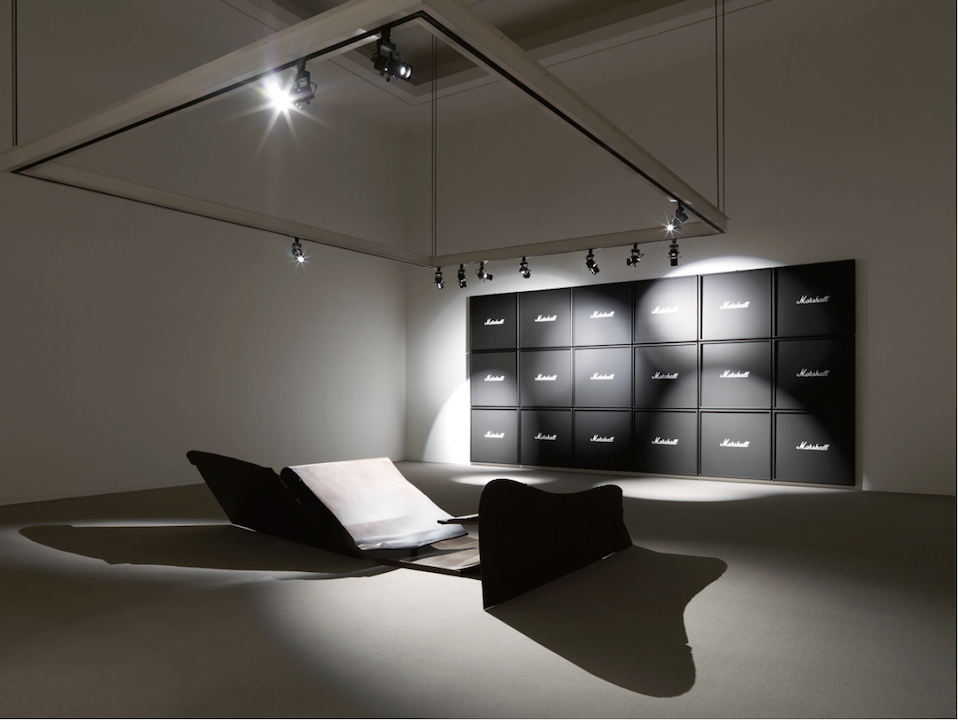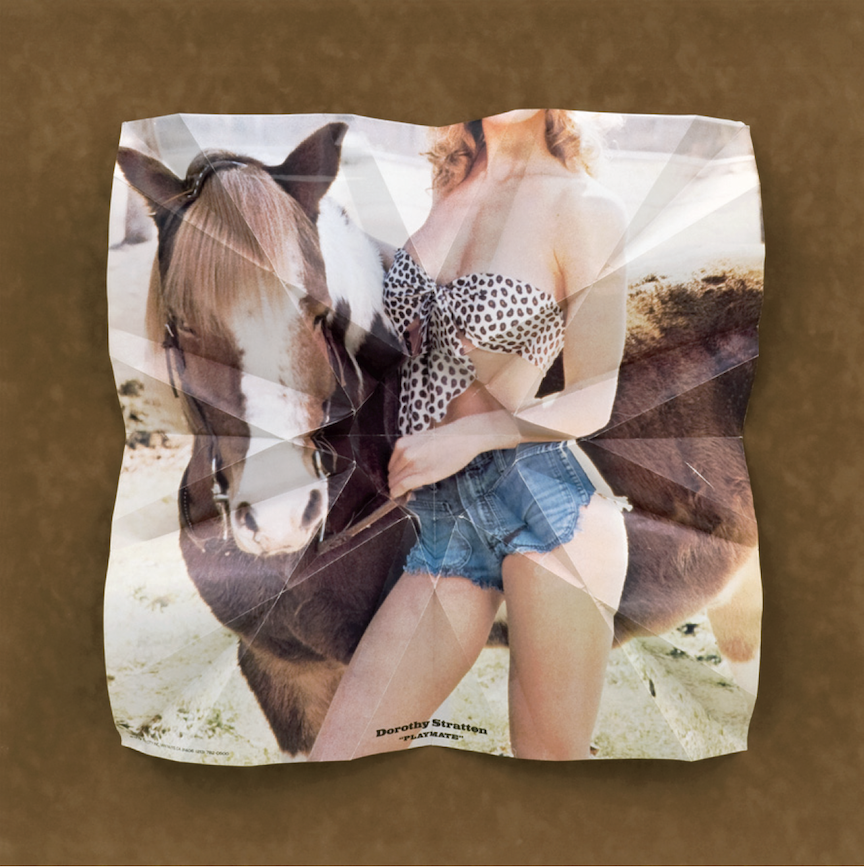Myfanwy MacLeod
When you first walk into the darkened gallery, it takes a little time for your eyes and mind to adjust. The rusty remains of a Chevy Camaro are suspended sideways on an auto mechanic’s rotisserie, like a pig on a spit. The walls are painted black and song lyrics in black metallic vinyl are mounted on them, executed in the kind of pseudo-Gothic typeface beloved of heavy metal bands. Silhouetted images of leafless trees with twining roots and branches, also laser-cut from black metallic vinyl, also applied directly to the black walls, create the feeling of being lost at night in an enchanted forest. And in one corner of the room, a black fibreglass floor sculpture resembles a succession of frozen waves or curving shark fins. The effect is both challenging and amusing.
Welcome to Myfanwy MacLeod, or “There and Back Again,” a 15-year survey of the Vancouver artist’s sculptures, paintings, mixed-media installations, photography, origami, appropriated imagery and recontextualized found objects. Collaboratively organized by the Vancouver Art Gallery and Museum London (where it debuted last year), the exhibition highlights a number of MacLeod’s preoccupations, mostly having to do with her irreverent readings of popular culture (she has said that it’s the language she knows) and modernist art—(the language most post-modernists know—and enthusiastically deconstruct). Welcome, too, to “Cock and Bull,” the “artist’s choice” exhibition which MacLeod curated from the VAG’s permanent collection, and which ranges from Female Nude, a 1917 Egon Schiele drawing, to Black Night Rip by Glenn Toppings and Dallas Selman (it’s the 1969 floor sculpture lurking in that first dark gallery), and from William Marlow’s 18th-century oil painting of Stonehenge to Derek Brunen’s 2007 video installation Plot, based on a day-long performance in which he digs a grave for himself.

Myfanwy MacLeod, installation view “Or There and Back Again,” 2014, Vancouver Art Gallery. Photograph: Rachel Topham. Courtesy Vancouver Art Gallery.
It is not uncommon for the VAG to invite featured artists to organize such shows. What is unusual is that rather than create a separate and distinct exhibition, MacLeod has completely integrated it with her solo outing, which was cur-ated by the VAG’s Grant Arnold and Museum London’s Cassandra Getty. This makes for a fascinating dialogue of forms, images and ideas, especially because much of MacLeod’s work is about critiquing or deconstructing the kind of visual culture that many of these VAG pieces represent. A few of her selections complement her art in formal and thematic ways but most are darkly ironic: they represent the kind of modernist aesthetic and gender politics to which her practice stands in cheeky opposition. She also assumes the role of agent provocateur, having deliberately chosen only works by male artists for “Cock and Bull,” a title that immediately reveals her skeptical attitude. Her choices spotlight the systemic sexism that underlies Modernism and also has shaped public collections in this country and beyond. The obvious feminist strategy would be to champion art by other women, but that’s not how MacLeod’s satirical mind operates. She hasn’t exactly placed gorilla masks over the faces of the female objects of the male gaze, but the impact is similar.
MacLeod’s art has long taken an unexpectedly funny and iconoclastic form, from a water fountain in the shape of a bullet-ridden cartoon frog to a folksy wooden outhouse with a blue interior to monstrously huge statues of English sparrows, set down in a public plaza. As seen in this survey exhibition, her recent focus has been on the way popular culture has constructed masculinity. Her critique is especially attuned to the 1970s, when she was coming of age in London, Ontario. Among the masculine tropes she mashes together and simultaneously deconstructs are the suburban muscle car (that Chevy Camaro, Chevrolet’s super-charged answer to the Ford Mustang), the heroic journey (as described in the fantasy literature of JRR Tolkien, wildly popular during the 1960s and ’70s), teenage lust (as revealed by Playboy centrefolds, in the days before internet porn), and cock rock music (as pioneered by Led Zeppelin). Alienated teenagers of the 1970s are further referenced by aspects of the show’s installation: walls are left intentionally unfinished to suggest the raw suburban basements that became adolescent hang-outs; a drug-culture poster is mounted above a pseudo-mystical, pop-icon sculpture, Presence; home-made speakers take the shape of geodesic domes, Don’t Stop Dreaming; and a cheap cabinet with mirrored inter-iors holds oversized reproductions of hybrid marijuana buds, named after a notorious criminal, Albert Walker.
The overarching theme of the show is of the journey, from its title, which is a direct allusion to Tolkien’s male-centric, mythic-quest book, The Hobbit, or There and Back Again, to its carefully considered design and layout. The artist’s personal and creative travels between London and Vancouver are also alluded to. You walk through galleries that alternate between darkness and light, throbbing sexuality and chilly minimalism, soaring aspiration and banal death. Stack, MacLeod’s wall of black paintings mimicking an iconic stack of Marshall speakers, alludes not only to the stadium rock phenomenon of hugely amplified sound associated with Led Zeppelin and other bands of the era, but also to Donald Judd’s “stacks” of metal units, developed around the same time.
They also, amusingly, analogize visual art to theatre, and curation to set design. Installed in front of Stack is Anthony Caro’s 1974 Bow, a big, abstract, metal sculpture. It represents what MacLeod sees as “macho male Modernism,” a bravura performance, again the product of the cock rock and Marshall stack era.

Myfanwy MacLeod, Gimme Sunshine, 2011, Dorothy Stratten pin-up poster, flocked matte board, Plexiglas. Collection of Andrea Thomas-Hill Gallery. Courtesy Vancouver Art Gallery.
Musical and performative allusions are also folded into Don’t Stop Dreaming, a mixed-media installation built around two home-made speakers that MacLeod purchased in a pawn shop. There’s a somewhat obscure subtext here concerning the medieval origins of pawn shops and the funding of journeys into the unknown. More immediately compelling, however, is that the speakers, assembled from multiple cheap components, take the shape of geodesic domes set on vertical posts. The domes evoke both the idealism inherent in modernist architecture and the aspirations of 1970s counter culture, for which the geodesic dome became a symbol of alternative living.
What drives this work, however, is the looping soundtrack, which intertwines excerpts from Leonardo DiCaprio’s narration from the 2000 movie The Beach, a recording of the female leader of a spin class, exhorting her acolytes to peddle faster and try harder, and inspirational music by the techno band Orbital. DiCaprio intones about his generation’s “circling the globe to find something they’d never tried before” and the spin-class instructor urges, “Get to the top! Get to the top! Keep going! We’re almost there!” At a media preview of her exhibition, MacLeod talked about the conspicuous irony that people on stationary bicycles never get “there”: no matter how hard they peddle, their journey is imaginary and their destination unachievable. She didn’t mention what seemed obvious to many—that the rhythmic, breathy talk of the instructor against the equally rhythmic music simulated the approach to an orgasm that can never be experienced. Climax, like that mythical destination, is eternally elusive.
Appropriately enough, the sexually charged soundtrack of Don’t Stop Dreaming infuses a nearby gallery’s works, making reference to the short life and tragic death of Playboy model Dorothy Stratten, the Vancouver-born woman who was “discovered” at the age of 14 by the man who would become her manager, her husband and her murderer. Stratten was named “Playmate of the Year” in 1980, the same year she was killed, and her story was subsequently told in two films and a book, all created by men. In the exhibition catalogue, art historian Joseph Monteyne analyzes how male desire attempts to fix the vulnerable and unstable female body within the highly prescriptive format of the Playboy centrefold. MacLeod creates a visual and verbal pun by folding as a form of intervention: she has made origami animals out of posters of Stratten, so that her lips, boobs and bum are strangely reconfigured, and two-dimensional imagery is ushered back into three-dimensional form. The objectifying and fetishizing male gaze is disrupted, thwarted, in complex ways. Less successful, however, are the Stratten posters and pin-ups that MacLeod has folded up and then reopened and displayed as pictures on the wall. In theory, the creases speak to the semiotics of the centrefold, but in practice, the original images of the naked young woman predominate.
The photos of her objectified body—the body of a living human being who became a powerless pawn in a game invented and perpetrated by a series of controlling men—is not sufficiently altered to function as either critique or intervention. But whether her work succeeds or fails, MacLeod guides us through a journey that opens our eyes, ears and minds to the unexpected. Keep going! Keep going! We’re almost there! ❚
“Myfanwy MacLeod, or There and Back Again” and “Artist’s Choice: Cock and Bull” were exhibited at the Vancouver Art Gallery, from March 8 to June 8 2014.
Robin Laurence is a Vancouver-based writer, curator and Contributing Editor to Border Crossings.

